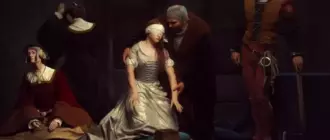
Tachism is a style of painting, which is characterized by a rejection of the objective depiction of reality. Tachism has become one of the trends of abstractionism in Western Europe. Artists who painted in the style of Tachism applied strokes to the canvas without prior thought – they were guided by their mental state and listened to emotions. The founder of the direction is considered Wols (German Wols) – a photographer from France, who was born in Berlin.
Tashism is not an accidental name. It comes from the French word tache, which means “spot”. Many of the paintings painted by the Tashists really resemble an accumulation of color spots – bright, light, most often evoking light and uplifting emotions.

The main characteristics and features of tachism
Tachism is often viewed as an offshoot of such a style as informationism (fr. Art Informel). The latter got its name for the refusal to use any form whatsoever. They do not exist in Tashism either. The direction is characterized by:
- bright spots of color, which were often created by splashing onto canvas;
- an abundance of large, powerful strokes;
- experimenting with scratches, drops, squeezing paint directly from a tube, using perforated containers, applying several layers of paint and partially scraping one of them;
- ill-considered actions of the author, his improvisation;
- rhythmically repeating elements;
- some artists use calligraphy techniques.
In the works written by the Tashists, with rare exceptions, the material, objective component is completely absent. And the more interesting this style.

History of Tashism
The forerunners of Tachism were attempts by surrealist artists to use elements of the technique of the future style – in particular, “automatic writing”. Such attempts were made in the 40s of the last century. Tachism was completed in France in the 1950s. The persons who gave him development abandoned the elements of geometric abstraction and relied on instinctive, intuitive self-expression through spots and strokes.
The Dictionary of 20th Century Art, published in Oxford, says that the term “Tachism” was first used in 1951. The new trend gained popularity after the publication in 1952 by art critic Michel Tapié de Céleyran of the book Un Art autre. Tachism was a response to Cubism – he opposed the broken lines of the latter with the brightness and smoothness of color spots. In addition, art critics of the mid-20th century viewed the new style as one of the branches of lyrical abstractionism and art informal, considered it the Western European equivalent of abstract expressionism.

After World War II, the Parisian school of Tachism began to develop rapidly. By the mid-50s. of the last century, artists, critics and the public of Europe began to cool towards Tashism. Constructivist artist and historian of avant-garde art Michel Seuphor declared that this direction of painting had finally reached a dead end. The paintings painted by the Tashists are exhibited in many museums, including the largest ones – the Tate Gallery in London, Berlin’s New National Gallery and others.
The most famous Tashist painters
Famous Tashist painters loudly declared themselves in the middle of the 20th century, when Tashism flourished. The list of the brightest names is such as:
- Hans Hartung (German Hans Hartung, 1904-1989). From his youth, this author showed a great interest in astronomy. The craving for contemplation of heavenly bodies and their traces was reflected in his works. In “Radiation” (1962), intersecting lines are clearly visible, creating a twinkling effect and reminiscent of the movement of stars and planets.
- Georges Mathieu (1921-2012). This master is considered the founder of abstract historical painting. Events from history are reflected in his paintings, written in the style of Tachism – for example, such as “Capetians Everywhere” (1954).
- Asger Jørn (date Asger Oluf Jørgensen, 1914-1973). The manner of this Danish author has gradually changed over time. In the 50s. of the last century, he tended to depict dark demonic creatures, fetishes and dark forces in his Tashist works. These characters are seen in the painting “A Letter to My Son” (1957).
- Pierre Soulages (fr. Pierre Soulages, born in 1919). A cross-cutting theme of all paintings by this French master is the active use of black. This thrust is clearly visible in his work Black and Blue (1973).
- Nicolas de Staël (fr.Nicolas de Staël, 1914-1955). The favorite colors of this artist from France were rich yellows, blues and reds. Their combination can be seen in the painting Red Bottles (1948).
Paintings














